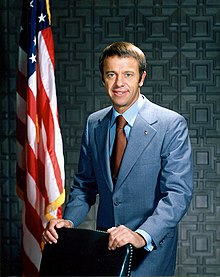
Back Alan Shepard Afrikaans Alan Shepard AN ألان شيبارد Arabic الان شيبارد ARZ Алан Шэпард Byelorussian Алън Шепърд Bulgarian অ্যালান শেপার্ড Bengali/Bangla Alan Shepard Breton Alan Shepard Catalan ئالان شێپەرد CKB
Alan Shepard | |
|---|---|
 Shepard in 1971 | |
| Born | Alan Bartlett Shepard Jr. November 18, 1923 Derry, New Hampshire, U.S. |
| Died | July 21, 1998 (aged 74) Pebble Beach, California, U.S. |
| Education | United States Naval Academy (BS) Naval War College (MA) |
| Spouse |
Louise Brewer (m. 1945) |
| Children | 2 |
| Awards | |
| Space career | |
| NASA astronaut | |
| Rank | Rear Admiral, USN |
Time in space | 9d 0h 57m |
| Selection | NASA Group 1 (1959) |
Total EVAs | 2 |
Total EVA time | 9h 23m |
| Missions | |
Mission insignia | |
| Retirement | July 31, 1974 |
Alan Bartlett Shepard Jr. (November 18, 1923 – July 21, 1998) was an American astronaut. In 1961, he became the second person and the first American to travel into space and, in 1971, he became the fifth and oldest person to walk on the Moon, at age 47.
A graduate of the United States Naval Academy at Annapolis, Shepard saw action with the surface navy during World War II. He became a naval aviator in 1947, and a test pilot in 1950. He was selected as one of the original NASA Mercury Seven astronauts in 1959, and in May 1961 he made the first crewed Project Mercury flight, Mercury-Redstone 3, in a spacecraft he named Freedom 7. His craft entered space, but was not capable of achieving orbit. He became the second person, and the first American, to travel into space. In the final stages of Project Mercury, Shepard was scheduled to pilot the Mercury-Atlas 10 (MA-10), which was planned as a three-day mission. He named Mercury Spacecraft 15B Freedom 7 II in honor of his first spacecraft, but the mission was canceled.
Shepard was designated as the commander of the first crewed Project Gemini mission, but was grounded in October 1963 due to Ménière's disease, an inner-ear ailment that caused episodes of extreme dizziness and nausea. This was surgically corrected in 1968, and in 1971, Shepard commanded the Apollo 14 mission, piloting the Apollo Lunar Module Antares. He was the only one of the Mercury Seven astronauts to walk on the Moon. During the mission, he hit two golf balls on the lunar surface.
Shepard was Chief of the Astronaut Office from November 1963 to August 1969 (the approximate period of his grounding), and from June 1971 until April 30, 1974. On August 25, 1971, he was promoted to rear admiral, the first astronaut to reach that rank. He retired from the United States Navy and NASA on July 31, 1974.
© MMXXIII Rich X Search. We shall prevail. All rights reserved. Rich X Search